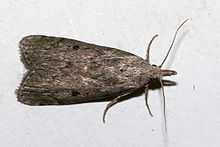Galleriinae
| Galleriinae | |
|---|---|
_cropped.png) | |
| Tirathaba rufivena of tribe Tirathabini | |
| Scientific classification | |
| Kingdom: | Animalia |
| Phylum: | Arthropoda |
| Class: | Insecta |
| Order: | Lepidoptera |
| Family: | Pyralidae |
| Subfamily: | Galleriinae Zeller, 1848 |
| Type species | |
| Phalaena cereana Blom, 1764 | |
| Diversity | |
| 5 tribes (and see text) About 70 genera About 300 species | |
| Synonyms | |
|
Macrothecinae Barnes & McDunnough, 1912 | |
The Galleriinae are a subfamily of snout moths (family Pyralidae) and occur essentially world-wide, in some cases aided by involuntary introduction by humans. This subfamily includes the wax moths, whose caterpillars (waxworms) are bred on a commercial scale as food for pets and as fishing bait; in the wild, these and other species of Galleriinae may also be harmful to humans as pests.
At the species level, they are the least diverse snout moth subfamily according to current knowledge, with about 300 described species altogether. However, as regards major lineages, the Galleriinae are quite diverse, with 5 tribes being recognized – more than in the Phycitinae, the most species-rich snout moth subfamily. One of these tribes, the Joelminetiini, has been described only in 2007, and presently contains a single and highly aberrant genus.
Description and ecology

Scale bar: 0.5 mm
The caterpillar larvae of Galleriinae usually have a sclerotised (hardened) ring around the base of seta SD1 on the first abdominal segment. Their pupae are comparatively easy to distinguish from other snout moths' by a readily apparent midline ridge running along the thorax and abdomen. In the imagines, the gnathos of the male genitalia is reduced to the point of disappearing altogether or (more rarely) with only the barest vestige remaining; this is quite characteristic except for a few Chrysauginae which have convergently lost the gnathos. Males produce very high chirping sounds with their tegulae, in some cases even regular "mating songs", though without specialized bioacoustics equipment this cannot be used for identification. Unusual for Pyralidae, adult Galleriinae may lack ocelli and even the proboscis (which is usually well-developed in the family); as typical for the family, however, they usually have large labial palps which form a "snout".[1]
Ecologically, the subfamily is noted for a number of species that coevolved with Hymenoptera, namely Apoidea (bees and relatives). The larvae may be parasites or symbionts, and the adults of such species at least to some degree are inquilines (though usually pursued by the nest inhabitants). Especially notable among these Galleriinae are the waxworms (Achroia and Galleria larvae) which are both significant as beekeeping pests and as commercial items, as well as Aphomia species. Others, especially the Rice Moth (Corcyra cephalonica) and Paralipsa, are noted pests of stored food products.[2]
Systematics
The diversity of Galleriinae known in the mid 20th century was fully catalogued by P.E.S. Whalley of the UK Natural History Museum, but no dedicated phylogenetic analysis has been conducted. Nonwithstanding, such studies exist for the Pyraloidea as a whole, and these indicate that the Galleriinae are a rather primitive lineage of Pyralidae, comparable to the Chrysauginae. The latter may be the closest living relatives of the Galleriinae, or an independent but equally ancient snout moth lineage that simply looks similar due to sharing many plesiomorphic traits.[2]
The Galleriinae are currently divided into 5 tribes, though this may change eventually. For one thing, some genera are presently insufficiently studied or too aberrant to be firmly assignable to any one tribe; for another, in the absence of detailed phylogenetic studies the best systematic treatment for members of this subfamily remains a best-guess. Furthermore, not all Galleriinae are known to science; new species and genera continue to be discovered. A supposed additional tribe ("Macrothecini") is based on a misidentified specimen of Cacotherapia interalbicalis; on the other hand the genus Joelminetia, of which the first specimens reached the hands of researchers only in the 1990s, turned out to be so distinct as to warrant establishment of its own monotypic tribe.[3]

The tribes and genera – with some significant species also noted – in this subfamily are:[4]
|
Cacotherapiini Munroe, 1995 (= Macrothecini)
Galleriini Zeller, 1848
Joelminetiini Speidel & Witt, 2007
Megarthridiini Whalley, 1964
|
Tirathabini Whalley, 1964
|
|
Footnotes
References
| Wikimedia Commons has media related to Galleriinae. |
- Jia, Feng-You; Greenfield, Michael D. & Collins, Robert D. (2001): Ultrasonic Signal Competition Between Male Wax Moths. Journal of Insect Behavior 14(1): 19–33. doi:10.1023/A:1007893411662 PDF fulltext
- Pitkin, Brian & Jenkins, Paul (2004): Butterflies and Moths of the World, Generic Names and their Type-species – Macrotheca. Version of November 5, 2004. Retrieved May 29, 2011.
- Savela, Markku (2011): Markku Savela's Lepidoptera and some other life forms: Galleriinae. Version of March 8, 2011. Retrieved May 29, 2011.
- Solis, M. Alma (2007): Phylogenetic studies and modern classification of the Pyraloidea (Lepidoptera). Revista Colombiana de Entomología 33(1): 1–8 [English with Spanish abstract]. HTML fulltext
- Zhou, Yihong; Kuster, Heidi K.; Pettis, Jeffrey S.; Danka, Robert G.; Gleason, Jennifer M. & Greenfield, Michael D. (2008): Reaction Norm Variants for Male Calling Song in Natural Populations of Achroia grisella (Lepidoptera: Pyralidae): towards a Resolution of the Lek Paradox. Evolution 62(6): 1317–1334. doi:10.1111/j.1558-5646.2008.00371.x PDF fulltext Supporting Information